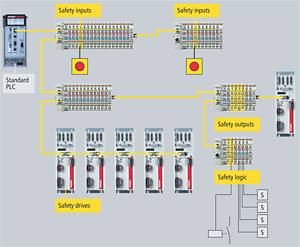Tech Flash Vol 6, No. 14 -- Food Engineering's E-Newsletter

The processor joined efforts with Southern California Gas Co. (SoCalGas) through its Energy Efficiency Calculated Incentive Program to build an efficient, green plant on a renovated site in
“Working with SoCalGas has helped us to lower our manufacturing and energy costs,” says Lucy Gonzalez, vice president of sustainability, Mission Foods. “We are committed to creating sustainable operations-not just lowering costs, but also reducing our carbon footprint.”
Mission Foods also joined the Cool Planet Project, an energy-efficiency and climate change mitigation program administered by The Climate Registry (The Registry) and SoCalGas. The Cool Planet Project helps Mission Foods understand the connection between energy usage and green house gas (GHG) emissions. Business customers that install significant energy-efficiency projects also receive assistance in measuring their carbon footprint and emissions reductions through The Registry.
The Panorama City plant’s sustainable efforts include rooftop solar panels for generating some of its own electricity, heat recovery systems and systems that minimize water usage. Employing approximately 150 on its staff, the facility will initially focus on meeting the growing retail demand for Mission products within Los Angeles County.
Dairy industry rejects proposed supply management programs
At a workshop in late June, Agriculture Secretary Tom Vilsack and Assistant Attorney General Christine Varney, head of DOJ’s antitrust division, heard from a panel of dairy farmers from across the country who complained about falling prices for their products. “The dairy industry has been hit particularly hard over the past eighteen months,” says Vilsack, “and, like other agricultural sectors, is experiencing consolidation and shrinking farm numbers. A fair and competitive marketplace is important not only for producers, but also for consumers.”
Dairy state senators Herb Kohl (D-WI) and Russ Feingold (D-WI) also spoke at the workshop. Kohl, who is chairman of the Senate Antitrust Subcommittee, says he would like to know why consumers seem to be paying more for dairy products at a time when farm milk prices are falling. “Over the last several years the dairy industry has seen considerable consolidation in marketing, processing and retail. The growing market power by some firms leaves family farmers with few bidders for their milk and tough terms of sale,” Kohl says. “This consolidation means we need strong antitrust enforcement now more than ever.”
Kohl says strong competition is the best insurance producers will get the best price for milk. He says policymakers should determine whether competition is healthy enough in the dairy industry to protect farmers, and if not, what to do about it.
The International Dairy Foods Association (IDFA), the Washington-based trade group representing dairy processors, says it will fight any attempt it sees as a government-imposed system to limit supplies of milk to boost producers’ prices. “I’m not going to mince words,” IDFA President and CEO Connie Tipton told more than 80 dairy company leaders last month. “Supply management will destroy our dairy industry’s opportunity for the future.”
Tipton says government-mandated supply-management programs, intended to reduce price volatility for dairy farmers, would only add more complexity to the system and would decrease demand for dairy products and ingredients by encouraging non-dairy substitutions in foods and restaurants across the country.
Tyson-Syntroleum fats/greases plant ready to go
The new facility is designed to convert fats, greases and oils supplied by Tyson Foods into as much as 75 million gallons of renewable fuels per year. The first shipments of animal fats have already been delivered to the facility.
Construction and maintenance personnel will continue to address punch list items as the commissioning and start-up of the plant proceed. “The commissioning activities we have in progress include flushing of all lines, verifying operation of the control system and installation of catalysts and absorbents,” says Jeff Bigger, director of the Dynamic Fuels Management Committee. “We currently expect to begin making fuel and ramping up production rates during the third quarter of 2010.”
“We’re pleased with customer interest in our fuel and the sales arrangements we’ve made so far,” adds Bob Ames, vice president of renewable energy for Tyson Foods. “We’re anxious to begin producing and selling our renewable fuel products, which have measurable performance and environmental advantages over conventional petroleum-based fuels.”Automation News

Trap and condensate optimization saves water and energy for West Coast brewery
In the beer-making process, the brewery uses steam-to-water, plate and frame heat exchangers to heat water. A condensate recovery system collects condensate from the exchangers and sends it to a pressurized receiver on the floor below, where it is emptied by four pressure-powered pumps. Prior to this effort, the brewery had 155 steam traps, about a third of which were orifice devices and working steam flow meters.
Miller Coors’ Irwindale brewery worked with Spirax Sarco, Inc. to perform a detailed review of its systems to identify opportunities to improve the water and energy usage efficiency.
Spirax Sarco provided recommendations for improving condensate recovery by 70 to 85 percent, thereby reducing make-up water consumption. The supplier collaborated with representatives of Southern California Gas Company (SoCalGas), which provided guidance for business incentive qualifications applied to conservation initiatives. While staying within MillerCoors’ budget, the team was committed to ensuring the supplier met MillerCoors’ expectations at each step of the project as well as the goal of saving water.
Spirax Sarco and SoCalGas representatives performed a steam trap system survey and a condensate return system assessment. The trap survey uncovered condensate losses due to incorrect applications of orifice-style steam traps, in addition to traps that had failed opened. The condensate return system assessment revealed the pressurized receiver was designed for electric pumps, while the system was using non-electric pressure powered pumps. Consequently, condensate removal was not optimal, resulting in flooding and maintenance problems with the relatively new heat exchangers. Also suspected was dumping of condensate to attain required temperature, which exacerbated the water consumption problems.
One aspect of the supplier’s proposed optimization strategy centered on obtaining energy savings by repairing failed-open traps. This strategy qualified for SoCalGas rebates, which helped to fund a portion of the project. Also helpful was the supplier team’s economic modeling. It demonstrated total water savings that became available by eliminating orifice and other traps that often plug and fail closed. The supplier’s team proposed the installation of 61 universal traps to replace 45 orifice traps and 16 failed traps to improve condensate recovery.
Another aspect of the strategy was the team’s recommendation that MillerCoors replace the steam traps connected to each of the five heat exchangers with automatic pump trap skids. The team also recommended replacing the pressurized collection receiver with the supplier’s fabricated collection receiver and five pressure-powered pumps. The proposal was presented as a turn-key project including installation and project management. The Spirax Sarco team committed to finishing all proposed work in less than one month from receipt of the MillerCoors purchase order, which required coordination with the brewery’s heavy production schedule.
With the project completed on time and within budget, the brewery met its water and energy-savings target in the packaging building. The results showed attainment of the 85 percent condensate recovery goal, with an annual savings of 5,369,274 gallons of water and 305,894 therms (1 therm = 100,000 BTU). As a result, the brewery experienced a faster equipment heat-up time and improved packaging capacity and throughput.
For more information, contact Steve Beatty at Spirax Sarco, 800-883-4411.
Safety protocol for EtherCAT accepted by IEC committees
The Safety-over-EtherCAT protocol is referred to as FSCP 12 (Functional Safety Communication Profile) in the IEC 61784-3 specification. This standard defines the fundamental requirements of a communication system in terms of safety-relevant data transmission. It also defines potential errors and describes possible recognition and corrective measures.
The Safety-over-EtherCAT protocol was introduced in 2005 by the EtherCAT Technology Group (ETG) and has been widely used in applications worldwide. The protocol is ideal for applications up to the Safety Integrity Level SIL3 according to IEC 61508. Safety communication and standard communication use a single-bus system.
Usage of Safety-over-EtherCAT, however, is not limited to EtherCAT. By employing the black channel-approach (i.e., the communication system plays no part in the safety considerations), safety quality is independent of the communication channel. Thus, EtherCAT, Ethernet, other fieldbus systems, underlying sub-bus systems and even wireless communication links are allowed on the same wire.
Confirmed by certification from TÜV SÜD, Safety-over-EtherCAT data containers are routed via standard controllers and gateways to neighboring systems where they are interpreted in a safe manner. Therefore, one safety domain can successfully span the entire installation.
“Safety-over-EtherCAT is simple to implement, bus independent and open,” says Dr. Guido Beckmann, who oversees the Safety-over-EtherCAT technology within the ETG. “The acknowledgement of this well-proven safety protocol as an international standard is yet another logical step towards the proliferation of EtherCAT technology. It provides additional assurance to both device manufacturers and end users who can depend on a stable and globally-accepted technology.”
The publication of the international standard IEC 61784-3 Ed.2 is expected soon. EtherCAT is an international standard (IEC, ISO and SEMI).Food Safety News

Government agencies collaborate on food safety improvements
The agencies have been collaborating to reduce foodborne illness as part of the Food Safety Working Group, organized by the White House. The Working Group recommends a public health-focused approach to food safety based on the principles of prioritizing prevention, strengthening surveillance and enforcement, and improving response and recovery.
FDA Deputy Commissioner for Foods Michael Taylor says the meetings will focus on how the agencies measure progress in reducing risk, because it’s “an important part of our food safety strategy.” He says the agencies need to know what works and what doesn’t.
“What doesn’t get measured doesn’t get done,” says USDA Deputy Under Secretary for Food Safety Jerold R. Mande. “To meet the President’s food safety goals, we need clear, effective measures of food safety so that government and industry can be held accountable by the public.”
Chicken imports still under scrutiny
“This clearly was a decision based on facilitating trade, not protecting the public health,” says Rep. Rosa L. DeLauro (D-CT). “The evidence is overwhelming that the Chinese food safety system is inadequate, and this ruling is a gross violation of basic public health protections. It should be our utmost priority to protect our citizens, including their health, and that means scrutinizing products from countries whose food safety systems pose risks.”
The

Six food colors must carry warning labels in EU
The colors are Tartrazine (E102), Quinoline Yellow (E104), Sunset Yellow (E110), Carmoisine (E122), Ponceau 4R (E124) and Allura Red (E129).
Any food or drink containing one or more of the six colors-except drinks with more than 1.2% alcohol-must provide the warning on the label that the color “may have effects on activity and attention in children.” Food and drink products produced before July 20 can continue to be marketed, but any products manufactured after that date must have the new markings.
The Center for Science in the Public Interest (CSPI) says it hopes the European labeling rule gets the attention of officials at FDA. According to CSPI, a 2004 meta-analysis concluded artificial dyes affect children’s behavior, and two recent studies funded by the British government found mixtures of dyes (as well as the preservative sodium benzoate) adversely affect kids’ behavior.Looking for a reprint of this article?
From high-res PDFs to custom plaques, order your copy today!





